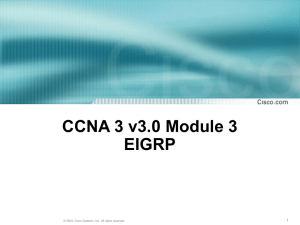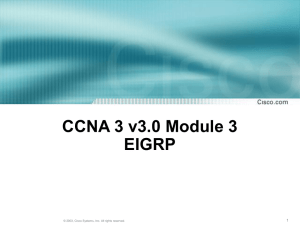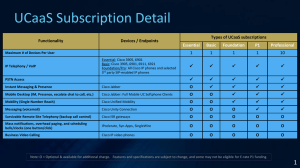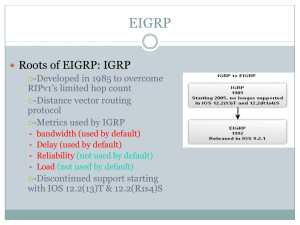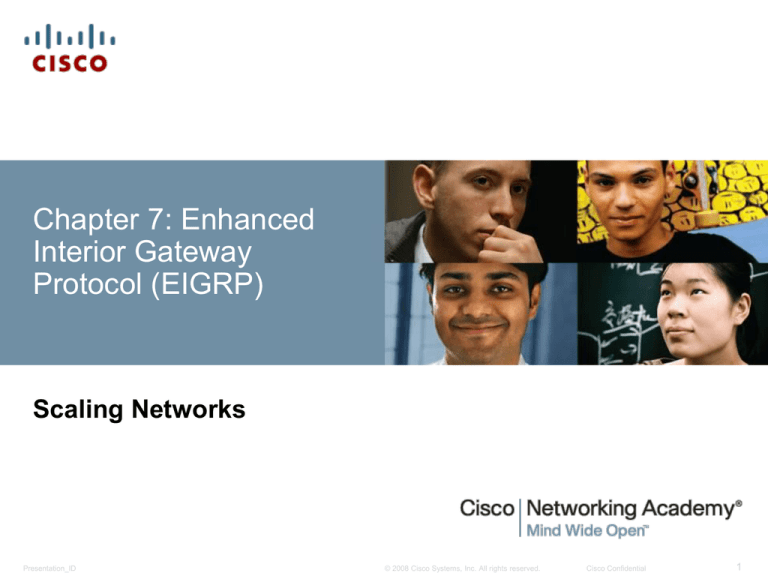
Chapter 7: Enhanced
Interior Gateway
Protocol (EIGRP)
Scaling Networks
Presentation_ID
© 2008 Cisco Systems, Inc. All rights reserved.
Cisco Confidential
1
Chapter 7
7.0 Introduction
7.1 Characteristics of EIGRP
7.2 Configuring EIGRP for IPv4
7.3 Operation of EIGRP
7.4 Configuration of EIGRP for IPv6
7.5 Summary
Presentation_ID
© 2008 Cisco Systems, Inc. All rights reserved.
Cisco Confidential
2
Chapter 7: Objectives
Describe the features and operation of EIGRP.
Examine the different EIGRP packet formats.
Calculate the composite metric used by the Diffusing Update
Algorithm (DUAL).
Describe the concepts and operation of DUAL.
Examine the commands to configure and verify basic EIGRP
operations for IPv4 and IPv6.
Presentation_ID
© 2008 Cisco Systems, Inc. All rights reserved.
Cisco Confidential
3
7.1 Characteristics of EIGRP
Presentation_ID
© 2008 Cisco Systems, Inc. All rights reserved.
Cisco Confidential
4
Basic Features of EIGRP
Features of EIGRP
Released in 1992 as a Cisco proprietary protocol.
2013 basic functionality of EIGRP released as an open standard.
Advanced Distance Vector routing protocol.
Uses the Diffusing Update Algorithm (DUAL) to calculate paths and
back-up paths.
Establishes Neighbor Adjacencies.
Uses the Reliable Transport Protocol to provide delivery of EIGRP
packets to neighbors.
Partial and Bounded Updates. Send updates only when there is a
change and only to the routers that need the information.
Supports Equal and Unequal Cost Load Balancing.
Presentation_ID
© 2008 Cisco Systems, Inc. All rights reserved.
Cisco Confidential
5
Basic Features of EIGRP
Protocol Dependent Modules
Presentation_ID
© 2008 Cisco Systems, Inc. All rights reserved.
Cisco Confidential
6
Basic Features of EIGRP
Reliable Transport Protocol
Presentation_ID
© 2008 Cisco Systems, Inc. All rights reserved.
Cisco Confidential
7
Basic Features of EIGRP
Authentication
EIGRP can be
configured to
authenticate routing
information.
Ensures routers only
accept updates from
routers that have
been configured with
the correct
authentication
information.
Presentation_ID
© 2008 Cisco Systems, Inc. All rights reserved.
Cisco Confidential
8
Types of EIGRP Packets
EIGRP Packet Types
Presentation_ID
© 2008 Cisco Systems, Inc. All rights reserved.
Cisco Confidential
9
Types of EIGRP Packets
EIGRP Hello Packets
Used to discover EIGRP neighbors.
Used to form and maintain EIGRP neighbor adjacencies.
Sent as IPv4 or IPv6 multicasts.
IPv4 multicast address 224.0.0.10.
IPv6 multicast address FF02::A.
Unreliable delivery.
Sent every 5 seconds (every 60 seconds on low-speed NBMA
networks).
EIGRP uses a default Hold timer of three times the Hello
interval before declaring neighbor unreachable.
Presentation_ID
© 2008 Cisco Systems, Inc. All rights reserved.
Cisco Confidential
10
Types of EIGRP Packets
EIGRP Update & Acknowledgement Packets
Update packets are sent to
propagate routing
information, only when
necessary.
Sends Partial updates – only
contains information about
route changes.
Sends Bounded updatessent only to routers affected
by the change.
Updates use reliable
delivery, therefore, require
an acknowledgement.
Presentation_ID
© 2008 Cisco Systems, Inc. All rights reserved.
Cisco Confidential
11
Types of EIGRP Packets
EIGRP Query and Reply Packets
Used when searching for networks.
Queries use reliable delivery, which can be multicast or unicast.
Replies use reliable delivery.
Presentation_ID
© 2008 Cisco Systems, Inc. All rights reserved.
Cisco Confidential
12
EIGRP Messages
Encapsulating EIGRP Messages
Presentation_ID
© 2008 Cisco Systems, Inc. All rights reserved.
Cisco Confidential
13
EIGRP Messages
EIGRP Packet Header and TLV
Presentation_ID
© 2008 Cisco Systems, Inc. All rights reserved.
Cisco Confidential
14
7.2 Configuring EIGRP for IPv4
Presentation_ID
© 2008 Cisco Systems, Inc. All rights reserved.
Cisco Confidential
15
Configuring EIGRP with IPv4
EIGRP Network Topology
This course uses the topology that configures EIGRP with IPv4.
Presentation_ID
© 2008 Cisco Systems, Inc. All rights reserved.
Cisco Confidential
16
Configuring EIGRP with IPv4
Autonomous System Numbers
The router eigrp autonomous-system command enables
the EIGRP process.
The autonomous system number is only significant to the EIGRP
routing domain.
The EIGRP autonomous system number is not associated with the
Internet Assigned Numbers Authority (IANA) globally assigned
autonomous system numbers used by external routing protocols.
Internet Service Providers (ISPs) require an autonomous system
number from IANA.
ISPs often use the Border Gateway Protocol (BGP), which does
use the IANA autonomous system number in its configuration.
Presentation_ID
© 2008 Cisco Systems, Inc. All rights reserved.
Cisco Confidential
17
Configuring EIGRP with IPv4
Router EIGRP Command
Router(config)# router eigrp autonomous-system
To completely remove the EIGRP routing process from a device,
use the no router eigrp autonomous-system command.
Presentation_ID
© 2008 Cisco Systems, Inc. All rights reserved.
Cisco Confidential
18
Configuring EIGRP with IPv4
EIGRP Router ID
Used in both EIGRP and OSPF routing protocols, the router ID’s
role is more significant in OSPF.
Presentation_ID
© 2008 Cisco Systems, Inc. All rights reserved.
Cisco Confidential
19
Configuring EIGRP with IPv4
Configuring the EIGRP Router ID
Configuring the EIGRP router ID
Router(config)# router eigrp autonomous-system
Router(config-router)# eigrp router-id ipv4-address
The IPv4 loopback address can be used as the router ID.
If the eigrp router-id value is not configured, the highest
loopback address is selected as the router ID.
Configuring a loopback interface
Router(config)# interface loopback number
Router(config-if)# ip addressipv4-address subnet-mask
Presentation_ID
© 2008 Cisco Systems, Inc. All rights reserved.
Cisco Confidential
20
Configuring EIGRP with IPv4
Network Command
Enables any interface on this router that matches the network
address in the network router configuration mode command to
send and receive EIGRP updates.
These networks are included in EIGRP routing updates.
Presentation_ID
© 2008 Cisco Systems, Inc. All rights reserved.
Cisco Confidential
21
Configuring EIGRP with IPv4
Network Command
The eigrp log-neighbor-changes router configuration mode
• On by default
• Displays changes in neighbor adjacencies
• Verifies neighbor adjacencies during configuration
• Indicates when any adjacencies have been removed
Presentation_ID
© 2008 Cisco Systems, Inc. All rights reserved.
Cisco Confidential
22
Configuring EIGRP with IPv4
The Network Command and Wildcard Mask
To configure EIGRP to advertise specific subnets only, use the
wildcard-mask option with the network command.
Router(config-router)# network network
address [wildcard-mask]
The wildcard mask is the inverse of the subnet mask.
To calculate the wildcard mask, subtract the subnet mask from
255.255.255.255:
255.255.255.255
-- 255.255.255.252
0. 0.
0. 3 wildcard mask
Note: Some IOS versions also let you enter the subnet mask
instead of a wildcard mask.
Presentation_ID
© 2008 Cisco Systems, Inc. All rights reserved.
Cisco Confidential
23
Configuring EIGRP with IPv4
Passive Interface
Use the passive-interface command to:
Prevent neighbor adjacencies
Suppress unnecessary update traffic
Increase security controls, such as preventing unknown rogue
routing devices from receiving EIGRP updates
To configure:
Router(config)# router eigrp as-number
Router(config-router)# passiveinterface interface-type interface-number
To verify:
Router# show ip protocols
Presentation_ID
© 2008 Cisco Systems, Inc. All rights reserved.
Cisco Confidential
24
Configuring EIGRP with IPv4
Verifying EIGRP: Examining Neighbors
Presentation_ID
© 2008 Cisco Systems, Inc. All rights reserved.
Cisco Confidential
25
Configuring EIGRP with IPv4
Verifying EIGRP: show ip protocols Command
Presentation_ID
© 2008 Cisco Systems, Inc. All rights reserved.
Cisco Confidential
26
Configuring EIGRP with IPv4
Verifying EIGRP: Examine the IPv4 Routing Table
Presentation_ID
© 2008 Cisco Systems, Inc. All rights reserved.
Cisco Confidential
27
7.3 Operation of EIGRP
Presentation_ID
© 2008 Cisco Systems, Inc. All rights reserved.
Cisco Confidential
28
EIGRP Initial Route Discovery
EIGRP Neighbor Adjacency
Presentation_ID
© 2008 Cisco Systems, Inc. All rights reserved.
Cisco Confidential
29
EIGRP Initial Route Discovery
EIGRP Topology Table
Presentation_ID
© 2008 Cisco Systems, Inc. All rights reserved.
Cisco Confidential
30
EIGRP Initial Route Discovery
EIGRP Convergence
Convergence – All routers have the correct, most up-to-date
information about the network.
Presentation_ID
© 2008 Cisco Systems, Inc. All rights reserved.
Cisco Confidential
31
Metrics
EIGRP Composite Metric
Presentation_ID
© 2008 Cisco Systems, Inc. All rights reserved.
Cisco Confidential
32
Metrics
Examining Interface Values
BW – Bandwidth of the
interface (in Kilobits per
second).
DLY – Delay of the
interface
(microseconds).
Reliability – Reliability of
interface; by default, the
value is not included in
the computing metric.
Txload, Rxload – By
default, the value is not
included in the
computing metric.
Presentation_ID
© 2008 Cisco Systems, Inc. All rights reserved.
Cisco Confidential
33
Metrics
Bandwidth Metric
Use the show interfaces command to verify bandwidth.
Most serial bandwidths are set to 1,544 kb/s (default).
A correct value for bandwidth is very important in order to calculate
the correct metric (both sides of link must have same bandwidth).
Presentation_ID
© 2008 Cisco Systems, Inc. All rights reserved.
Cisco Confidential
34
Metrics
Delay Metric
Presentation_ID
© 2008 Cisco Systems, Inc. All rights reserved.
Cisco Confidential
35
Metrics
Calculating the EIGRP Metric
Step 1. Determine the link with the slowest bandwidth. Use that value
to calculate bandwidth (10,000,000/bandwidth).
Step 2. Determine the delay value for each outgoing interface on the
way to the destination. Add the delay values and divide by 10
(sum of delay/10).
Step 3. Add the computed values for bandwidth and delay, and
multiply the sum by 256 to obtain the EIGRP metric.
Presentation_ID
© 2008 Cisco Systems, Inc. All rights reserved.
Cisco Confidential
36
DUAL and the Topology Table
DUAL Concepts
Diffusing Update ALgorithm (DUAL) provides the following:
Loop-free paths and loop-free backup paths
Fast convergence
Minimum bandwidth usage with bounded updates
The decision process for all route computations is done by the
DUAL Finite State Machine (FSM)
DUAL FSM tracks all routes.
Uses EIGRP metrics to select efficient, loop-free paths.
Identifies the routes with the least-cost path to be inserted into
the routing table.
EIGRP maintains a list of backup routes that DUAL has already
determined that can be used immediately if the primary path fails.
Presentation_ID
© 2008 Cisco Systems, Inc. All rights reserved.
Cisco Confidential
37
DUAL and the Topology Table
Successor and Feasible Distance
The Successor is the least-cost route to the destination network.
The Feasible Distance (FD) is the lowest calculated metric to reach
the destination network.
Presentation_ID
© 2008 Cisco Systems, Inc. All rights reserved.
Cisco Confidential
38
Feasible Successors, Feasibility Condition,
and Reported Distance
Feasible Successor (FS) is a neighbor that has a loop-free backup
path to the same network as the successor, and it satisfies the
Feasibility Condition (FC).
Feasibility Condition (FC) is met when a neighbor’s Reported
Distance (RD) to a network is less than the local router’s feasible
distance to the same destination network.
Reported Distance (RD) is an EIGRP neighbor’s feasible distance
to the same destination network.
Presentation_ID
© 2008 Cisco Systems, Inc. All rights reserved.
Cisco Confidential
39
DUAL and the Topology Table
Topology Table: show ip eigrp Command
Presentation_ID
© 2008 Cisco Systems, Inc. All rights reserved.
Cisco Confidential
40
DUAL and the Topology Table
Topology Table: No Feasible Successor
Presentation_ID
© 2008 Cisco Systems, Inc. All rights reserved.
Cisco Confidential
41
DUAL and Convergence
DUAL Finite State Machine (FSM)
Presentation_ID
© 2008 Cisco Systems, Inc. All rights reserved.
Cisco Confidential
42
DUAL and Convergence
DUAL: Feasible Successor
Presentation_ID
© 2008 Cisco Systems, Inc. All rights reserved.
Cisco Confidential
43
DUAL and Convergence
DUAL: No Feasible Successor
Presentation_ID
© 2008 Cisco Systems, Inc. All rights reserved.
Cisco Confidential
44
7.4 Configuration of EIGRP for IPv6
Presentation_ID
© 2008 Cisco Systems, Inc. All rights reserved.
Cisco Confidential
45
EIGRP for IPv4 vs. IPv6
EIGRP for IPv6
Presentation_ID
© 2008 Cisco Systems, Inc. All rights reserved.
Cisco Confidential
46
EIGRP for IPv4 vs. IPv6
Comparing EIGRP for IPv4 and IPv6
Presentation_ID
© 2008 Cisco Systems, Inc. All rights reserved.
Cisco Confidential
47
EIGRP for IPv4 vs. IPv6
IPv6 Link-local Addresses
Presentation_ID
© 2008 Cisco Systems, Inc. All rights reserved.
Cisco Confidential
48
Configuring EIGRP for IPv6
EIGRP for IPv6 Network Topology
Presentation_ID
© 2008 Cisco Systems, Inc. All rights reserved.
Cisco Confidential
49
Configuring EIGRP for IPv6
Configuring IPv6 Link-Local Addresses
Manually configuring link-local addresses
Verifying link-local addresses
Presentation_ID
© 2008 Cisco Systems, Inc. All rights reserved.
Cisco Confidential
50
Configuring EIGRP for IPv6
Configuring EIGRP for the IPv6 Routing Process
The ipv6 unicast-routing global configuration mode
command is required to enable any IPv6 routing protocol.
Configuring EIGRP for IPv6
The no shutdown command and a router ID are required for the
router to form neighbor adjacencies.
Presentation_ID
© 2008 Cisco Systems, Inc. All rights reserved.
Cisco Confidential
51
Configuring EIGRP for IPv6
ipv6 eigrp interface Command
Enabling EIGRP of IPv6 on an Interface
Presentation_ID
© 2008 Cisco Systems, Inc. All rights reserved.
Cisco Confidential
52
Verifying EIGRP for IPv6
Verifying EIGRP for IPv6: Examining Neighbors
Presentation_ID
© 2008 Cisco Systems, Inc. All rights reserved.
Cisco Confidential
53
Verifying EIGRP for IPv6
Verifying EIGRP for IPv6: show ip protocols Command
Presentation_ID
© 2008 Cisco Systems, Inc. All rights reserved.
Cisco Confidential
54
Verifying EIGRP for IPv6
Verifying EIGRP for IPv6: Examine the Routing Table
Use the show ipv6 route command to examine the
IPv6 routing table.
Presentation_ID
© 2008 Cisco Systems, Inc. All rights reserved.
Cisco Confidential
55
Chapter 7: Summary
EIGRP is a classless, advanced distance vector routing protocol.
EIGRP uses the source code of “D” for DUAL in the routing table.
The default administrative distance of 90 is used for internal routes
and 170 for routes imported from an external source.
Advanced features include DUAL, establishing neighbor
adjacencies, RTP, partial and bounded updates, and equal and
unequal cost load balancing.
PDMs give EIGRP the capability to support different Layer 3
protocols.
EIGRP Hello packets are used to discover neighbors.
The show ip eigrp neighbors command is used to view
neighbor table and verify adjacencies.
Presentation_ID
© 2008 Cisco Systems, Inc. All rights reserved.
Cisco Confidential
56
Chapter 7: Summary (cont.)
EIGRP sends partial bounded updates when a change occurs on
network.
EIGRP composite metric uses bandwidth, delay, reliability and load
to determine the best path (by default, only bandwidth and delay are
used).
DUAL FSM is used to determine best path; Successor and potential
backup path, FS to every destination network.
Presentation_ID
© 2008 Cisco Systems, Inc. All rights reserved.
Cisco Confidential
57
Presentation_ID
© 2008 Cisco Systems, Inc. All rights reserved.
Cisco Confidential
58


